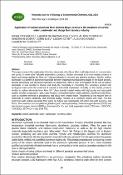Options
Application of sodium aluminate from alumina Bayer process to the treatment of surface water, wastewater and sludge from tannery industry
ISSN
2668-8530
Date issued
2024-07
Author(s)
DOI
10.21698/rjeec.2024.102
Abstract
This paper presents the application of sodium aluminate, directly or after small adjustments in concentration and purity, in some other valuable intermediary products. Sodium aluminate is an intermediary product in Bayer technology applied by Alum SA Tulcea production of alumina and alumina products. Mainly, sodium aluminate is a carrier of aluminum hydroxide between important manufacturing stages in the Bayer process, bauxite processing, and aluminum hydroxide crystallization. After a short investigation of the uses of sodium aluminate, it was decided to choose and study the possibility of converting this secondary product into ecological material for the treatment of natural or industrial wastewater. Actually, on the market, products similar to sodium aluminate from Alum SA Tulcea provide treated waters with high purity and reasonable quality, excellent coagulation rates, rapid flotation, and sedimentation, and in addition, significant side effects, such as excellent removal of phosphorus and silica from treated water. Treatments do not require lime or hydroxide to control alkalinity, and chemical sludge remains at a minimum volume and mass. The test performed with sodium aluminate from Alum SA Tulcea was comparable with other tests with Al2(SO4)3 and FeCl3. The maximum removal yields of global organic load expressed by chemical oxygen demand (COD) and biochemical oxygen demand (BOD5), chromium (Cr VI), and total suspended solids (TSS) were: 83%COD, 71% BOD5, 99.7% Cr VI and 93% TSS.
Files
Loading...
Name
Articol 02 Full.pdf
Description
Article
Size
879.46 KB
Format
Adobe PDF
Checksum
(MD5):b868720709fb8a238857a4f5359385ca